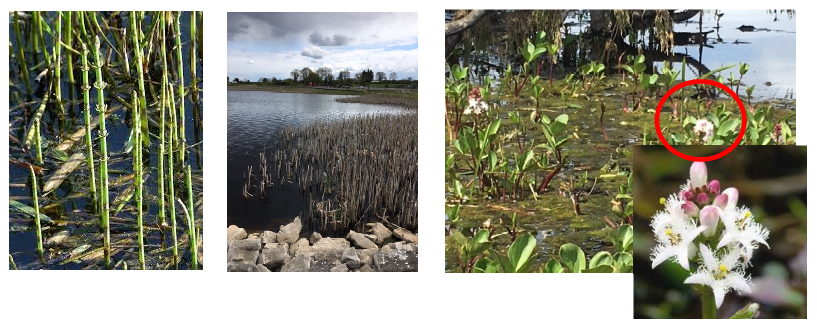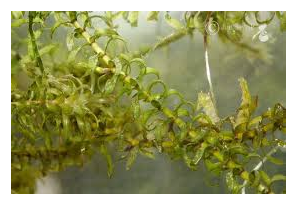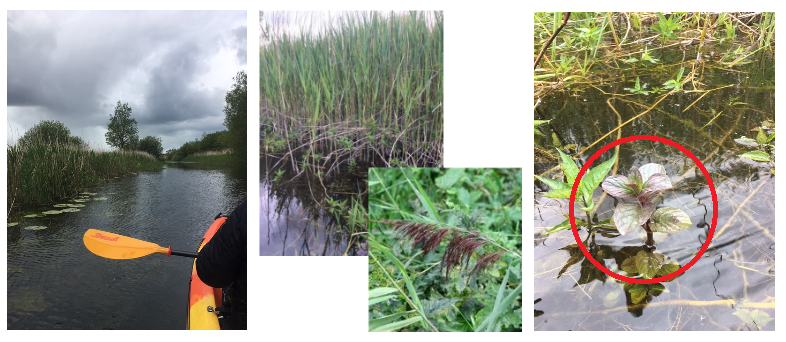Although many people enjoy recreation time at Portrunny Bay, so far little has been known about what’s living beneath the surface. The lakes ecosystem begins already at the margins of the lake, where plants and animals live part below and part above the water and continues into deeper water where life is adapted to a submerged environment.
Life at the margins of the lake
These marginal plants, as they are known at Portrunny include rushes, horsetails, and other plants such as Bog bean, water mint and lillys are a vital and integral part of the lake’s ecosystem. Creating their own habitat, these marginal areas are biological super-systems producing great volumes of food and shelter and breeding grounds to support a wide range of wildlife such as nesting birds, Amphibians, beetles, snails, butterflies, bees, fish, and small mammals such as bats and even otters. In addition to these functions which are essential to the lake ecosystem, these areas also provide ecosystem services to humans by providing buffering against flooding events and mopping up excess nutrients.
As Marginal plants are usually partly submerged and partly exposed, they are complex systems which facilitate lifecycles of insects which require both submerged and emergent to complete their lifecycles. Insects such as dragonflies and Mayflies transition from their submerged phase to the emergent phases above the water by climbing up the plants. Laccobius is a small water beetle found in Portrunny Bay only 3mm in length found on the emergent plants at the lake shore.

As we travel deeper into the lake at Portrunny Bay, marginal plants disappear and are replaced by plants adapted to living entirely below the water surface summered otherwise known as macrophytes such as Elodea water weed characterised by the curly leaves (see below). This non-native species, originating from North America is found in nutrient rich water such as those in Lough Ree.

Invertebrate Life of Portrunny Bay
Aquatic invertebrates are an important part of the lake’s ecosystem, and an essential component of the resident biodiversity. They play a very significant role in nutrients’ recycling and form an important portion of the food web of the lake. They can be very sensitive to water pollution and for this reason, they can be used an environmental indicator of change, letting us know if there have been changes in the water quality or habitat.
As well as the water quality, the bottom type determines the kinds of creature we find there, soft bottoms attracting burrowing worms and snails, whereas coarser sediments attract those that need hard substrate to settle on or coarse materials to engineer.
The hard surface of the marina and the rocks on the inside of the jetty of Portrunny Bay provide suitable for algae and in return there we find grazing snails including the margined Ramshorn Planorbis planorbis (See below). The soft bottom of the area between the breakwater and the marina along with the nutrient rich water provides suitable habitat for the whirled snail Bithynia spp. which feeds on the plentiful macrophytes. Sponges are the simplest animal form which we found in the lake and yet it plays a vital role in filtering tiny particles from the water and providing habitat and food for other aquatic insects. Sponges are known as a good indicator of ecosystem health and are therefore a welcome sight!
Moving outside the breakwater, into the centre of the bay where there is more water movement, coarser sediments are found and here Caddisfly larvae cases are found (see below). These are engineered by gluing small shell fragments together to achieve this precise shaped tube in which the larvae spend a vital stage of its life cycle.

The hard Stoney substrate enough habitat for a substantial a patch of the invasive mollusc Zebra mussel (Dreissena polymorpha). This species is classified as a bivalve meaning it has 2 shells and feeds by opening these shells and filtering the water. In this way they are passive feeding rather than the active forging of the snails found feeding on the plant life as mentioned above. Unfortunately, the rate at which they reproduced and the associated volumes of water which they filter can remove too much food from the water, depleting feedstocks for other filter feeding bivalves.
The River Hind
Finally, our journey takes us up the river hind which flows into the Bay. Rivers are vital transport corridors for any nutrient which enter the river on its journey. Here the habitat is visually different with the common reed lining the passage of the river (see below). Lillys float on the water’s surface and just below the surface grazing snails can be seen skimming off the layers of microalgae from their surfaces. The refreshing aroma of water mint (Mentha aquatica) breaks the surface. Further up the river where the water movement increases, we find a water beetle Elmidae on the edge of the river under some stones. They cannot swim and can leave the water and fly to find new locations.

Portrunny Bay is rich in habitats and biodiversity above and below the water, however many of the above water species such as birds rely on a healthy submerged ecosystem. It is up to all of us to protect this ecosystem. Littering is a problem at Portruuny Bay and many of these littering objects find their way into the water. Once in the water, plastics degrade into smaller particles and are taken up by invertebrate, fish and in turn birds. This creates a risk to the healthy ecosystem at Portruuny Bay. It is up to each of us to ensure that we leave no trace when we visit these areas.
